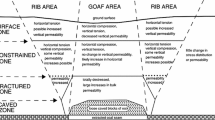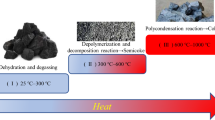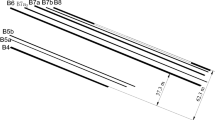Abstract
The permeability of broken coal is not only mainly controlled by coal structure, but also unavoidably influenced by variations of stress, particle size, moisture content, and temperature. In this paper, a self-designed experimental device was utilized to investigate the permeability evolution of seven coal samples with different particle size ratios during the loading processes under the condition of temperature, water content, and pore pressure. The results show that both the permeability and the porosity are negative exponential functions of axial stress. Under the same stress, the porosity and the permeability decrease with the increase of the particle size and the particle size range of the coal samples; in the process of compaction, the larger the particle size and the particle size range of the coal samples, the higher the change rate of the porosity and the permeability. Under the same stress, any increase of temperature, water content, or pore pressure would cause the decrease of the permeability of the coal samples, i.e., they are negatively correlated. With the establishment of the permeability calculation model of the coal samples under different temperatures, water contents, and pore pressures during the loading processes, the permeability of different locations in different environments can be speculated. Based on the estimated data, the air leakage in different areas can be obtained to determine the spontaneous combustion zone in goaf, which is crucial for fire prevention and control in goaf.










Similar content being viewed by others
Abbreviations
- Re :
-
Reynolds number
- ρ :
-
The density of fluid
- v :
-
The velocity of fluid
- μ :
-
The dynamic viscosity coefficient of nitrogen
- d :
-
The equivalent diameter of pipeline
- K 0 :
-
The initializing permeability of the coal sample
- Q :
-
The gas flow rate
- P 0 :
-
The atmospheric pressure
- P 1 :
-
The pressure of the inlet
- P 2 :
-
The pressure of the outlet
- L :
-
The length of the coal sample
- A :
-
The cross-section area of the coal sample chamber
- K i :
-
The permeability under the stress of the coal sample
- a :
-
A coefficient that depends on the fracture morphology of coal
- σ :
-
The stress
- n :
-
The porosity
- V 0 :
-
The apparent volume of porous media
- V i :
-
The absolute density of porous media
- ω :
-
The additional moisture increment of the coal sample
- M :
-
The total weight of the coal samples after soaking
- m :
-
The weight of the coal samples before soaking
- ΔK T :
-
The temperature change causes the change in the permeability
- ΔT :
-
The amount of change in temperature
- C :
-
A fitting coefficient, C < 0
- ΔKω :
-
The water content change causes the change in the permeability
- Δω :
-
The change in water content
- D :
-
A fitting coefficient, D < 0
- ΔK ϑ :
-
The pore pressure change causes the change in the permeability
- Δϑ :
-
The pore pressure variable quantity
- E :
-
A fitting coefficient, E < 0
References
Chen Z, Pan Z, Liu J, Connell DL, Elsworth D (2011) Effect of the effective stress coefficient and sorption-induced strain on the evolution of coal permeability: experimental observations. Int J Greenhouse Gas Control 5:1284–1293
Chen Z, Pan Z, Liu J, Connell DL (2013) An improved relative permeability model for coal reservoirs. Int J Coal Geol 109–110:45–57
Connell LD (2009) Coupled flow and geomechanical processes during gas production from coal seams. Int J Coal Geol 79(1–2):18–28
Czerw K (2011) Methane and carbon dioxide sorption/desorption on bituminous coal-experiments on cubicoid sample cut from the primal coal lump. Int J Coal Geol 85:72–79
da Costa Mattos HS, dos Reis JL, Angulo JAP (2015) Temperature effect on low permeability porous media filled with water at high pressures. Adv Water Resour 83:10–16
Han F, Busch A, van Wageningen N, Yang J, Liu Z, Krooss BM (2010) Experimental study of gas and water transport processes in the inter-cleat (matrix) system of coal: anthracite from Qinshui Basin, China. Int J Coal Geol 81:128–138
Harpalani S, Schraufnagel R (1990) Shrinkage of coal matrix with release of gas and its impact on permeability of coal. Fuel 69:551–556
Hildenbrand A, Schlömer A, Krooss BM (2002) Gas breakthrough experiments on fine-grained sedimentary rocks. Geofluids 2:3–23
Kelemen SR, Kwiatek LM (2009) Physical properties of selected block argonne premium bituminous coal related to CO2, CH4, and N2 adsorption. Int J Coal Geol 77:2–9
Levine JR (1996) Model study of the influence of matrix shrinkage on absolute permeability of coal bed reservoirs. Coalbed Methane Coal Geol 109:197–212
Li B (2013) Seepage characteristics of loaded coal containing gas and its application. China University of Mining and Technology, Beijing
Li ZQ, Xian XF, Long QM (2009) Experiment study of coal permeability under different temperature and stress. J China Univ Min Technol 38:523–527
Li JQ, Liu DM, Yao YB (2013) Evaluation and modeling of gas permeability changes in anthracite coals. Fuel 111:606–612
Li B, Wei JP, Wang K (2014) A method of determining the permeability coefficient of coal seam based on the permeability of loaded coal. Int J Min Sci Technol 24:637–641
Liu L, Xu WY, Wang HL, Wang W, Wang RB (2016) Permeability evolution of granite gneiss during triaxial creep tests. Rock Mech Rock Eng 49:3455–3462
Louis C (1969) Groundwater flow in rock weights and its influence on stability. Rock Mech. Res. Report 10. Imperial College, London
Ma D, Miao XX, Wu Y et al (2008) Seepage properties of crushed coal particles. J Petrol Sci Eng 146(2016):297–307
Majewska Z, Majewski S, Zietek J (2010) Swelling of coal induced by cyclic sorption/desorption of gas: experimental observations indicating changes in coal structure due to sorption of CO2 and CH4. Int J Coal Geol 83:475–483
Meng Y, Li ZP, Lai FP (2015) Experimental study on porosity and permeability of anthracite coal under different stresses. J Petrol Sci Eng 133:810–817
Monfared M, S J, D Pierre, Mohajerani M (2014) Temperature and damage impact on the permeability of opalinus clay. Rock Mech Rock Eng 2014(47):101–110
Moore TA (2012) Coalbed methane: a review. Int J Coal Geol 101:36–81
Morrow CA, Moore DE, Lockner DA (2001) Permeability reduction in granite under hydrothermal conditions. J Geophys Res Solid Earth 106(B12):30551–30560
Pan Z, Connell LC (2012) Modelling permeability for coal reservoirs: a review of analytical models and testing data. Int J Coal Geol 92:1–44
Perera MSA, Ranjith PG, Choi SK, Airey D (2012) Investigation of temperature effect on permeability of naturally fractured black coal for carbon dioxide movement: an experimental and numerical study. Fuel 94:596–605
Polak A, Yasuhara H, Elsworth D (2004) The evolution of permeability in natural fracturesthe competing roles of pressure solution and free-face dissolution. Elsevier Geo-Eng Book Ser 2:721–726
Rutqvist J, Freifeld B, Min KB et al (2008) Analysis of thermally induced changes in fractured rock permeability during 8 years of heating and cooling at the Yucca Mountain Drift Scale Test. Int J Rock Mech Min Sci 45(8):1373–1389
Scheidegger AE (1974) The physics of flow through porous media, 3rd edn. University of Toronto Press, Toronto
Teng T, Wang JG (2016) A thermally sensitive permeability model for coal-gas interactions including thermal fracturing and volatilization. J Nat Gas Sci Eng 32:319–333
Wang SG, Elsworth D, Liu JS (2011) Permeability evolution in fractured coal: the roles of fracture geometry and water-content. Int J Coal Geol 87:13–25
Warren JE, Root PJ (1963) The behavior of naturally fractured reservoirs. SPE J 3:245–255
Xu J, Peng S, Tao Y, Yang H (2009) Experimental analysis of influence of creep on permeability of gas-bering coal. Chin J Rock Mech Eng 28(11):2273–2279
Yin G, Jiang C, Wang J, Xu J (2013) Combined effect of stress, pore pressure and temperature on methane permeability in anthracite coal: an experimental study. Transp Porous Media 100(1):1–16
Yuan L, Smith AC (2008) Effects of ventilation and gob characteristics on spontaneous heating in longwall gob areas. In: Proceedings of 12th U.S./North American mine ventilation symposium, pp 141–147
Zhang ZF, Mart O, Mart D (2012) Relative permeability for multiphase flow for oven-dry to full saturation conditions. Int J Greenh Gas Control 49:259–266
Zhou S, Lin B (1990) The theory of gas flow and storage in coal seams. China Coal Industry Publishing House, Beijing
Acknowledgements
This study was supported by the National Natural Science Foundation of China (Nos. 51774114, 51574111, U1361205).
Author information
Authors and Affiliations
Corresponding author
Ethics declarations
Conflict of interest
The authors declare that they have no conflict of interest.
Additional information
Publisher's Note
Springer Nature remains neutral with regard to jurisdictional claims in published maps and institutional affiliations.
Rights and permissions
About this article
Cite this article
Chao, J., Yu, M., Chu, T. et al. Evolution of Broken Coal Permeability Under the Condition of Stress, Temperature, Moisture Content, and Pore Pressure. Rock Mech Rock Eng 52, 2803–2814 (2019). https://doi.org/10.1007/s00603-019-01873-x
Received:
Accepted:
Published:
Issue Date:
DOI: https://doi.org/10.1007/s00603-019-01873-x




